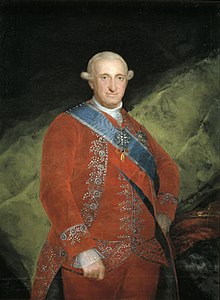Charles IV of Spain
| Charles IV | |||||
|---|---|---|---|---|---|

Portrait of Charles IV by Goya
|
|||||
| King of Spain (more...) | |||||
| Reign | 14 December 1788 – 19 March 1808 |
||||
| Predecessor | Charles III | ||||
| Successor | Ferdinand VII | ||||
| Born | 11 November 1748 Palace of Portici, Portici, Naples |
||||
| Died | 20 January 1819 (aged 70) Palazzo Barberini, Rome, Papal States |
||||
| Burial | El Escorial | ||||
| Spouse | Maria Luisa of Parma | ||||
| Issue |
Carlota Joaquina, Queen of Portugal and Brazil Infanta María Amalia María Luisa, Queen of Etruria Ferdinand VII Infante Carlos, Count of Molina María Isabel, Queen of the Two Sicilies Infante Francisco de Paula, Duke of Cadiz |
||||
|
|||||
| House | Bourbon | ||||
| Father | Charles III of Spain | ||||
| Mother | Maria Amalia of Saxony | ||||
| Religion | Roman Catholic | ||||
| Full name | |
|---|---|
| Carlos Antonio Pascual Francisco Javier Juan Nepomuceno José Januario Serafín Diego |
Charles IV (Spanish: Carlos Antonio Pascual Francisco Javier Juan Nepomuceno José Januario Serafín Diego; 11 November 1748 – 20 January 1819) was King of Spain from 14 December 1788, until his abdication on 19 March 1808.
Charles was the second son of Charles III and his wife, Maria Amalia of Saxony. He was born in Naples (11 November 1748), while his father was King of Naples and Sicily. His elder brother, Don Felipe, was passed over for both thrones, due to his learning disabilities and epilepsy. In Naples and Sicily, Charles was referred to as the Prince of Taranto. He was called El Cazador (meaning "the Hunter"), due to his preference for sport and hunting, rather than dealing with affairs of the state. Charles was considered by many to have been amiable, but simple-minded.
In 1788, Charles III died and Charles IV succeeded to the throne. He intended to maintain the policies of his father, and retained his prime minister, the Count of Floridablanca, in office. Even though he had a profound belief in the sanctity of his office, and kept up the appearance of an absolute, powerful monarch, Charles never took more than a passive part in his own government. The affairs of government were left to his wife, Maria Luisa, and his prime minister, while he occupied himself with hunting. In 1792, political and personal enemies ousted Floridablanca from office, replacing him with Pedro Pablo Abarca de Bolea, Count of Aranda. However, in the wake of the war against Republican France, the liberal-leaning Count of Aranda was himself replaced by Manuel de Godoy, a favourite of the Queen and widely believed to be her lover, who enjoyed the lasting favor of the King.
...
Wikipedia
